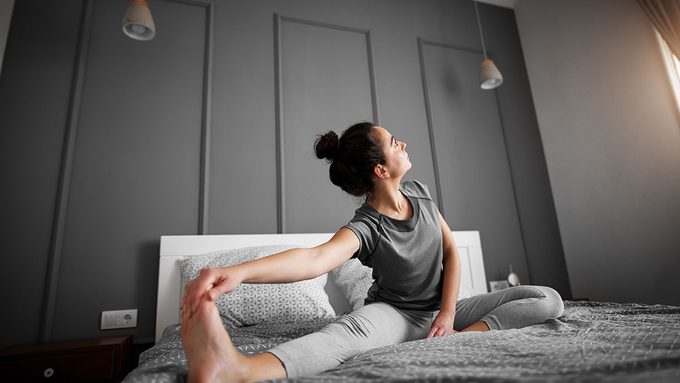Trouble Sleeping? A Yoga Teacher Fills You In On 3 Simple Fixes
These techniques are worth a shot.

Q: At night, my brain won’t shut off and I’m up for hours worrying. How can I fall asleep?
The yoga teacher says… I work with sleep science and yoga and relaxation techniques to help people get back to sleep. I typically begin by getting a history of when your sleep issues started and if any changes in your life or health precipitated the onset. I’d also ask you to track your sleep for about a week.
I would work with you on reprogramming your sleep response by doing everything from keeping the temperature in your room cool to reducing your sugar intake to keep your blood sugar stable. I’d encourage minimizing stressors, including addressing unhelpful thinking with cognitive behavioural therapy (CBT), and addressing stress as it arises with exercise, yoga and guided meditation. (In Toronto? Check out these new mediation studios to help you recharge.)
Trouble sleeping tip #1: Put away your smartphone
At night, lighting is key, because blue light emitted by devices can interfere with your body’s ability to produce the sleep hormone melatonin. I usually recommend that, for half an hour before bed, you keep lighting low — think warm candlelight levels — turn off the TV, turn off social media and engage in relaxing activities for half an hour.
Trouble sleeping tip #2: Make belly breathing part of your routine
I teach relaxation techniques that help turn off your stress response (a.k.a. the sympathetic nervous system, which is triggered by worried thoughts and interferes with sleep), and turn on your parasympathetic system, which promotes relaxation and is essential for the body to feel safe enough to sleep. One particularly effective technique is belly breathing. I like to use modified box breathing, in which you inhale for a count of four, pause, then exhale for a count of six, pause, and take a regular breath. You repeat alternating those counted breaths with regular breaths when you’re in bed to cue your body to relax and to refocus your mind on completing the pattern rather than on your worries.
Trouble sleeping tip #3: Prioritize a yoga pose before you hit the sheets
Another technique I teach is a simple pose that involves lying down and extending your legs up against your wall or headboard. It encourages relaxation. When you’re relaxed, there is less blood in your muscles and more blood in your core organs, while when you’re stressed, your body redirects blood to your muscles to prepare your body for fight or flight. Propping up your legs lets gravity pull the blood from your limbs to your core, signalling your body to adapt a more restful state. I also recommend doing deeply relaxing forward folds (like child’s pose or seated forward folds) before bed to encourage relaxation. These yoga poses can also help soothe your mind and body.
Some people will just come for a couple of sessions and find a few simple fixes were all they needed to help them sleep, but if you’ve had insomnia for a while, it may take longer and we would try more advanced mindfulness techniques.
And, here’s what a psychologist says you should do to treat insomnia.
Sarah Domes is a sleep coach and yoga teacher.




